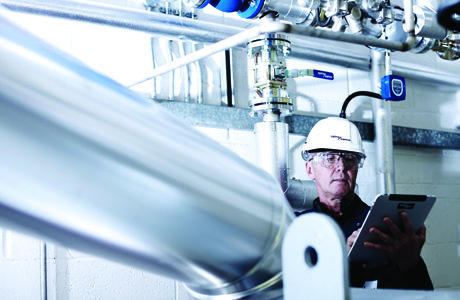
With budget constraints and an ever increasing pressure to reduce carbon emissions, the need to enhance productivity, cut maintenance workloads and improve system safety have become high on the agenda for energy centre operators. Chris Coleman, Marketing Product Manager – Condensate Handling at Spirax Sarco offers five ways to boost boiler house efficiency right from the heart of the steam system.
The boiler house is the engine room that powers the whole steam system, making it the ideal place for identifying efficiencies. By targeting the centre of the steam system we can find the best investments to reduce fuel consumption, carbon emissions, water use, and overall running costs. For operators, there are numerous ways this can be achieved.
Reverse osmosis
Reverse osmosis (RO) is a water purification technology used to remove minerals and eliminate boiler scaling, and is one of the simplest techniques to maximise operational savings. It works by using semi-permeable membranes with pores so fine 98 per cent of all salts are removed from the incoming supply, allowing water to pass through with minimal impurities. This diminishes the need for boiler treatment chemicals, reduces ongoing maintenance costs, fuel consumption and water and energy losses, and makes RO a cost-effective way to maximise savings with payback achieved in as little as 12-18 months.
Automatic total dissolved solids (TDS) control
The TDS blowdown process is essential to ensuring a clean, dry steam supply and can be accomplished either manually or automatically. During boiler operation, TDS levels will increase and may rise above accepted levels if not monitored. This will cause a foaming condition which will contaminate the steam and may cause priming to take place. It can also cause fouling and water hammer issues for control valves, heat exchangers and steam traps.
Automatic control systems measure the conductivity of the boiler water, compare it with a set point, and automatically open a blowdown control valve if the TDS level is too high. This maintains a constant TDS level and minimises the loss of water from the boiler, as well as associated energy losses.
Flash steam recovery
Flash steam is formed when high pressure condensate is exposed to a large pressure drop, often created during the blowdown process. Venting flash steam with no form of heat recovery wastes energy but, by recovering flash steam and feeding it back into the feed tank via a deaerator head, companies can make economic and environmental savings.
A flash vessel is just one method that can be used to recover energy by separating flash steam from condensate. As condensate enters the flash vessel, flash steam is produced and can be piped from the top of the vessel to the feed tank via the deaerator.
Float traps can be fitted to the outlet of the flash vessel where residual blowdown water will be drained. The water will still be hot at this point and is allowed to pass into the plated heat exchanger where it gives up its heat to the circulating cold make-up water. In other words, by using the hot water from the flash vessel, heat energy is recovered.
The use of both a flash vessel and plated heat exchanger pack, will allow you to recover up to 80 per cent of the energy from the rejected TDS water, which can also result in fuel savings, a reduction in carbon dioxide emissions, and the elimination of unsightly plumes of steam.
Exhaust gas heat recovery
Recovering heat from the exhaust gases of heavy fuel oil or biomass boilers can be difficult because dirt can block and damage conventional heat exchangers. Energy recovery from exhaust gases, however, can provide valuable savings and significant reductions in carbon emissions. Exhaust gas heat recovery systems work by making use of the heat that would have otherwise have left the system in the form of waste flue gasses. This recovered heat can be used to preheat the water entering the boiler thereby reducing the amount of additional energy required to boil the water.

The development of heat pipe technology can be used as the core heat exchange component for exhaust gas energy recovery. By using heat pipe technology, fuel costs and carbon emissions are lowered. This means the pipes become easy to maintain and ultimately prove to be an extremely effective way to cut operational costs.
Steam system conditioning
Steam system conditioning is based on the principle of water and condensate treatment optimising the efficiency of the entire steam system. A clean boiler is only one part of this, and water conditioning can be a hugely effective way to maximise energy efficiency. The feed water storage system is vital to the whole steam system, as it not only stores the energy in returned condensate for re-use in the boiler, but balances and deaerates returned condensate, flash steam and raw water supplies. Steam system conditioning can reduce chemical use, the risk of corrosion and maintenance costs, while increasing the reliability of the steam system. This results in greater productivity.
As outgoing costs and productivity levels have become a major priority for energy centre operators, these relatively simple but extremely effective measures can improve efficiency significantly. An efficient boiler house is crucial to the overall steam system and by implementing these techniques we hope that operators can see benefits both environmentally and economically.








